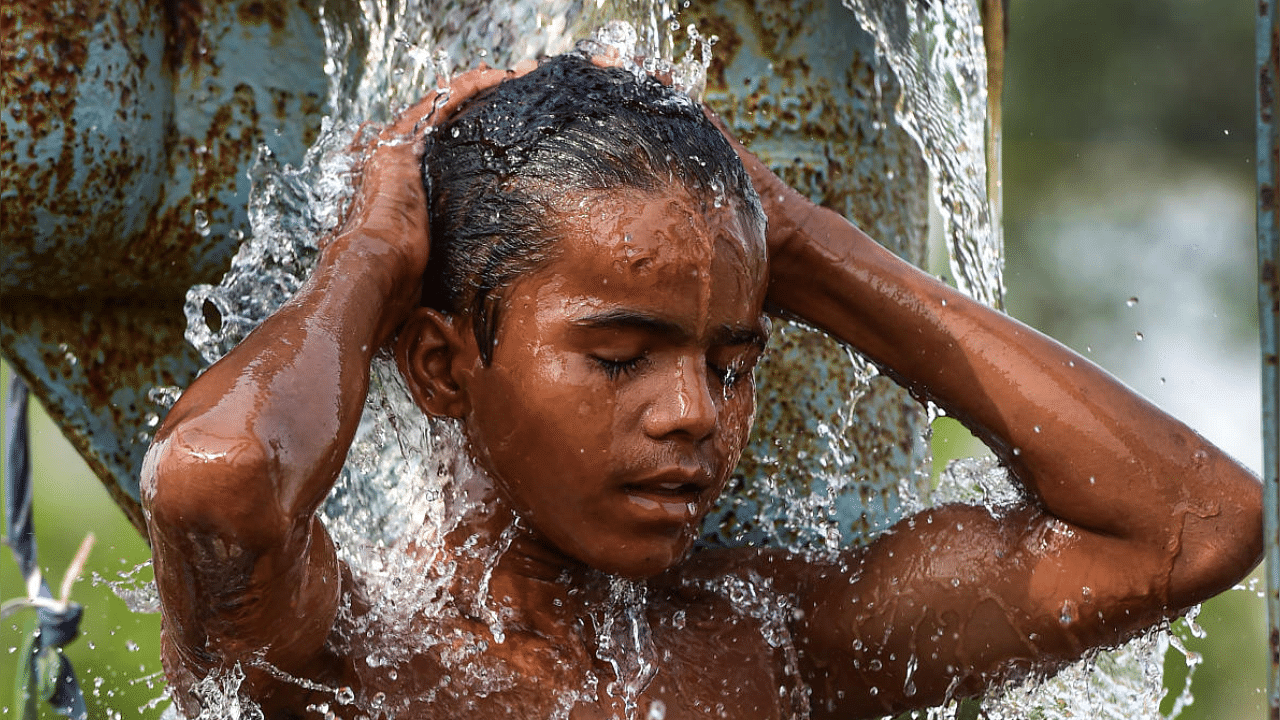
A child takes a bath under a leaking pipe to get respite from the scorching heat, in New Delhi. (Image for representation only.)
Credit: PTI File Photo
New Delhi: More than 84 per cent of the districts in India are prone to extreme heat waves and 70 per cent are experiencing a rise in the frequency and intensity of extreme rainfall events, according to a new analysis.
The report, "Managing Monsoons in a Warming Climate" by the independent developmental organisation IPE Global Limited and Esri India Technologies, said the country was experiencing extended summer-like conditions during the June-September monsoon.
Abinash Mohanty, head of Climate Change and Sustainability Practice at IPE Global Limited and the author of the study, said, "Our analysis suggests that eight out of 10 Indians will be highly exposed to extreme events by 2036."
"Embracing hyper-granular risk assessments and establishing climate-risk observatories should become a national imperative to safeguard Indian agriculture, industry and large-scale infrastructural projects from the vagaries of climate change," he said.
The report said Uttar Pradesh, Madhya Pradesh, Rajasthan, Gujarat and Tripura were the top five heatwave hotspot states in the 2013-22 decade.
It said 74 per cent of districts in the coastal regions, 71 per cent in the plains, and 65 per cent in the hills had 'high to very high' exposure to extreme heat waves.
Districts in the plains and hills experienced a 36 per cent increase in heatwave days during the 2013-22 decade while coastal districts recorded a 30 per cent rise, it added.
"Uttar Pradesh, Madhya Pradesh, Rajasthan, Gujarat and Tripura were the top five heatwave hotspot states in this decade," the report stated.
It also noted that the decade recorded fewer cumulative heatwave days compared to the previous two decades.
The decade's most impactful extreme heatwave event occurred in 2015, the second deadliest after the 1998 event.
The analysis suggested that during the March-May period and the subsequent June-September period, districts in the plains experienced the maximum number of heatwave days.
Coastal districts saw a decline in the number of heatwave instances, both in frequency and intensity, in the past decade, which could be attributed to the increase in cyclonic activities in the Bay of Bengal and the Arabian Sea.
Government data shows extreme heat and sunstroke claimed 10,635 lives in India over the 10 years from 2013.
Andhra Pradesh recorded 2,203 deaths during this period, the highest among all states, followed by Uttar Pradesh (1,485), Telangana (1,172), Punjab (1,030), Bihar (938), Maharashtra (867), Odisha (609), Jharkhand (517), Haryana (461), West Bengal (357), Rajasthan (345), Gujarat (263), and Madhya Pradesh (213).
Delhi recorded 13 such deaths.
The maximum number of deaths (1,908) were recorded in 2015.
This summer, India experienced 536 heatwave days, the highest in 14 years, with the northwestern region recording its warmest June since 1901, according to the India Meteorological Department (IMD).
The country recorded 181 heatwave days in June, the highest since 2010.
Official data shows that India recorded 41,789 suspected heat stroke cases and 143 heat-related deaths in 2024, during one of its hottest and longest heat waves.
The intense heat overwhelmed the water supply system and power grids, with Delhi grappling with a severe water crisis. Temperatures breached 50 degrees Celsius in parts of Rajasthan, with nighttime temperatures hovering around 35 degrees Celsius in many places.
In Delhi, which logged 40 consecutive days of temperatures above 40 degrees Celsius since May 13, there were around 60 heat-related deaths this year, according to reports.
Agendra Kumar, managing director of Esri India Technologies, said, "The increasing frequency and intensity of heat waves, in conjunction with intense precipitations, are causing significant impacts on lives, livelihoods and infrastructure. A holistic, data-driven approach is essential for informed policy decisions, climate adaptation and resilience."
"GIS (geographic information system) technology, with advanced spatial analysis tools and the ability to integrate a variety of data, enables a comprehensive understanding of the impact of climate from economic, social and environmental perspectives. Decision makers in the government can use it for resilient infrastructure planning and development, disaster management and citizen engagement," he added.
Kumar said businesses could integrate climate insights for better strategic planning and building higher resilience in supply chains and business operations.
GIS technology is already the core foundation of various disaster resilience programmes, infrastructure, utilities, natural resources management and missions such as Smart Cities Mission, Atal Mission for Rejuvenation and Urban Transformation (AMRUT), National Water Mission and Clean Ganga, among others, he said.